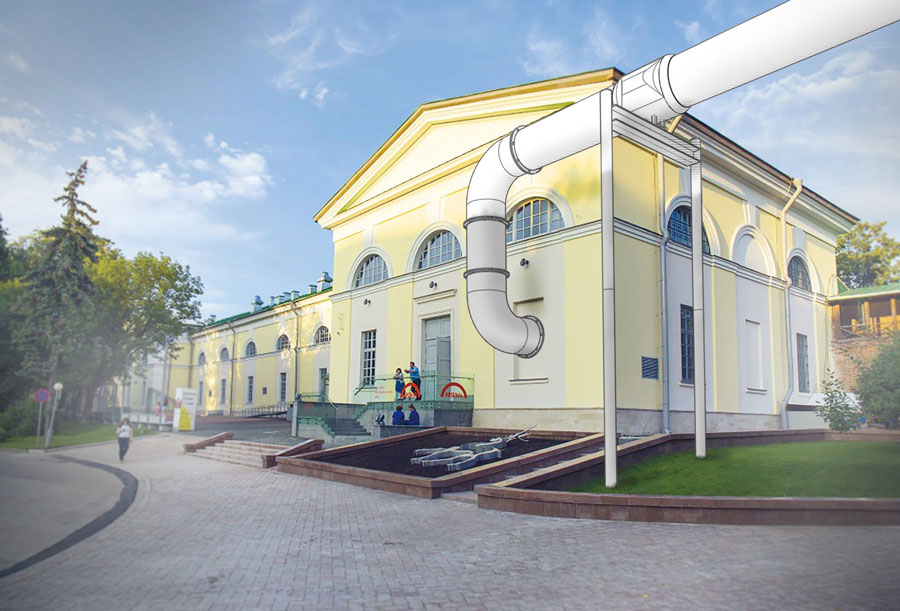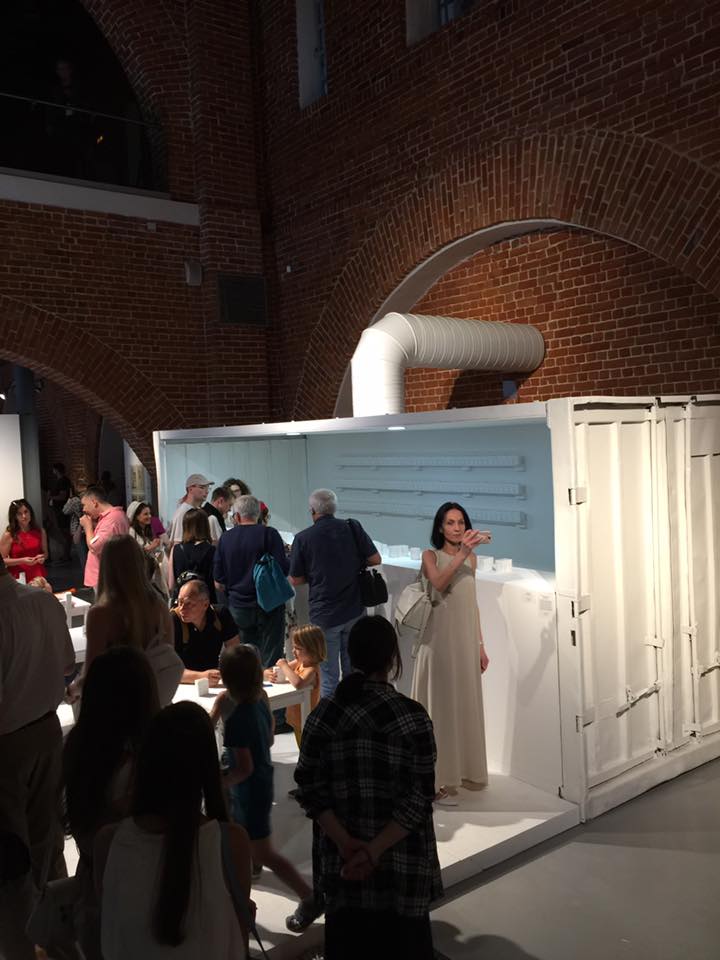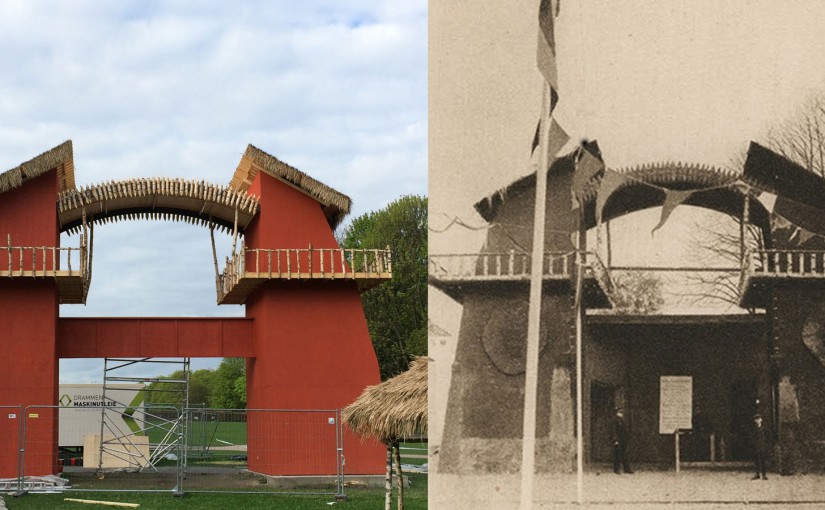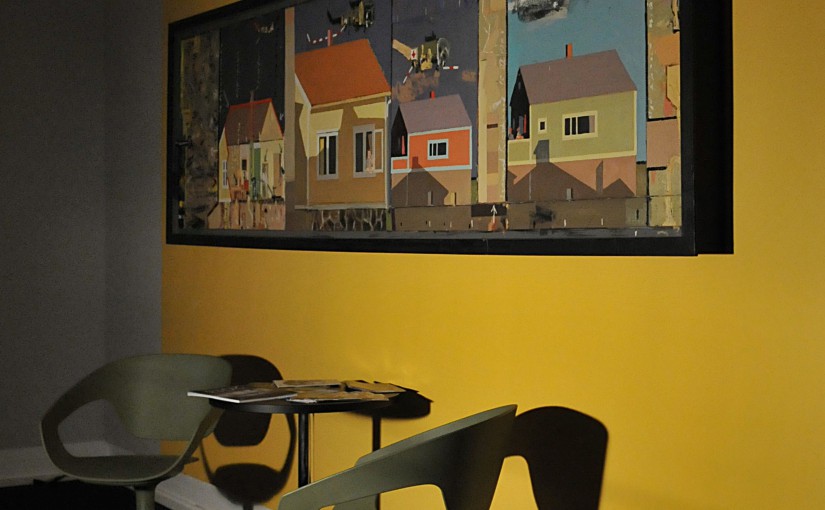Good From Far
“Swedish-Canadian Lars Cuzner is a trickster who you’re never sure is on the level. Using assumed identities and provocative language, his work has often sparked controversy, addressing uncomfortable topics such as racism, Nordic nationalism and the rise of right-wing populism all over Europe. As part of the festival’s ongoing Situation Reports, he roamed the streets as a self proclaimed “con-artist” interviewing politicians and the general public attempting to raise funds for his self help book that he describes as a ´really bad book.´” Forbes.com
Lars Cuzner’s “Good From Far” is about artistic research and literary production. This three-year endeavor aimed to explore the boundaries of publishing, authorship, and the commodification of ideas in the contemporary literary landscape.
The primary objective was to secure a book deal with a publisher without presenting any written content.
This is an excerpt from a terrible book, Good From Far, by me, Lars Cuzner.
It was never meant to be a good book and I lied to get it published. Actually, that’s not entirely true, I told people that I was lying, but I wasn’t. If you can’t get people to believe you, tell them you’re lying. So I told everyone that I’m a con artist. They didn’t believe me because I’m a conceptual artist. It’s a simple enough trick, which is a good thing, because in the confidence game, simplicity is your best friend.
The art scene, or the so called international contemporary art scene, to be exact, has internalised and accepted a set of social behaviours that in other areas of life would be considered scams. What this means is that in the arts, you can apply manipulation techniques that are used in straight up illegal cons without it being considered criminal. To understand this we need to look at the complex relationship the art profession has to insecurity.
Exactly no one is surprised to hear that cons are prevalent in the art world and I will explain why that is, but this book is not an exposé of art world high finance. It’s not about forgeries or money laundering. That’s a real thing though, art money is a massive con and one of our societies most accepted unregulated economies. But that is for another story. This is a self help book that explains the psychology of the confidence and insecurity game. The art scene just happens to be the perfect place to illustrate this particular kind of game.
I’m going to teach you in this book is how to use your insecurity to your advantage. First you need to understand that most people with influence in the art field confuse cultural power with power. The professional art world focuses on describing struggles and conflicts that will never effect the art world, and those who represent it will most likely believe that they are agents of real change in society. To con someone you need to make them first con themselves, and that is much easier with people who are already self-delusional about something that is so obviously not true.
Back to the opening statement of this introduction. This is actually a poorly written book and I don’t want anyone to correct it. I’m not just saying that to be coy, I’m trying to prove that I pulled off my con. Call it professional pride. I got the publishing deal before I had written anything. I am not an author and I have never published anything. I got this book deal because I’m an artist and I said that I was a con artist. The only promise I made was that the book would be bad. Since I’m an artist people just assumed that I wasn’t telling the truth. I’m using the art world to get a self help book published. To make money, obviously. That should sounds counter-intuitive. Art is necessarily selective and self help isn’t considered much of an art form. To pull this off I had to do a con.
First of all, know this. The easiest people to con are people who are highly educated and consider themselves intelligent. The reason for this is simple, they believe themselves to be above being duped. The perfect mark. The art profession attracts this type of person in droves since it yields irrational levels of social status. And because it’s a very small and competitive field, both in number of jobs and audience, it is overrepresented with easy victims of easy scams.
Disclaimer: Throughout this book you might find yourself thinking -“That’s not only true for the art world. That’s true in any profession” – and you would be correct in thinking so, but there are some specific differences that set the art profession apart, so let’s start there.
In theory, the art game is a pretty easy scam, the problem is that everyone who is playing it is insecure. The confidence game thrives on insecurity, but when everyone in the game is disguising their own insecurity, they are more sensitive to micro expressions of over-playing your confidence. The art game is about fluid confidence while struggling. I know, it’s confusing, and it has to be played over several years. In the art world you have to fake being a little bit fucked up, or fake being poor. It’s about being interesting. Easy living makes for boring people and everyone knows it.
The scam is to pretend that you are insecure but successful. This is confusing for people who are actually insecure. Competition is fierce and it doesn’t take much to get a bad reputation. You are constantly being read. Intelligence agents do this, they call it butt sniffing, like dogs do. They are professional bullshitters so they sniff out bullshit on the first meeting with anyone. You know that old joke? “Deja moo – The feeling that you’ve heard this bullshit before”. My kids always loved this joke and used to say it to me whenever I started telling them how this new project was the one to get us out of this crappy apartment.
When you’re getting started, you don’t really know why your efforts aren’t paying off. You don’t know what you’re doing wrong, and when it does work you don’t know why it worked. You’re just winging it. Because that’s what you do in the beginning. Nobody is showing you what to do, and they don’t teach you this in school, (because, frankly, the truth isn’t very flattering). In this confidence game you have to learn to use your insecurity as a weapon. I tell this to young aspiring artists and I tell them what works – not what they think works – but what actually works. If they listen to me they enjoy it more and get better results, they survive the game longer. Naturally, most young people are not receptive to this kind of advice and bless them for that.
The Intelligence Party
“With Lars Cuzner’s project “The Intelligence Party”, 2018, they finally arrived at the topicality, because Lars Cuzner has set up a fictional party here with which he moves in Graz as if he were on an election campaign tour. Tirelessly, the committed artist introduces the program of his “Intelligence Party”, a party that on the one hand demands the humanist demand for a right to vote for foreigners, and on the other hand supports this demand with right-wing arguments, such as true love of the homeland. The paradox seems hardly to go – and yet: in talks around post-colonialism, for example, “nationalism as a legitimate anti-colonial resistance movement” (Varela / Dhawan) is repeatedly discussed. The fact that steirischer herbst artistically discusses contradictions like these in various forms, is exactly what makes it so necessary this year.”
All across Europe, the right fears what they call “the Great Replacement,” where eroding European values supposedly cannot hold up to Islamic fundamentalism… and worse. The Intelligence Party, initiated by artist and activist Lars Cuzner, has a proposal to assuage these fears. Founded in Norway, the Intelligence Party is named after one of that country’s oldest political parties, which was led by romantic poet Johan Sebastian Welhaven in the 1830s. Today this party is reborn and appeals to cultural protectionists across Europe to enshrine the most important right of all: the right to vote. The universality of this right and its constant expansion is the most quintessentially European value of all, the Intelligence Party argues, and it should therefore be extended to non-citizen residents, regardless of where they come from. The party’s thinking goes that universal participation in elections would reveal more commonalities than expected between European and non-European residents, who might, it would turn out, share with conservative electorates a concern for family values, religious freedom, and the protection of cultural identity. That, at least, would stop any fundamentalist insurgency in its tracks, so the Intelligence Party proclaims. After spreading the party’s message in Norway and several other European countries, online, and in rousing public discussions, Cuzner now turns to Austria and Graz. Paradoxically injecting a left-wing demand into a right-wing agenda and presenting it to an undecided electorate, Cuzner and his party question today’s hackneyed notions of politics as well as the truth-procedures used to reach them.
You can read Lars Cuzner’s text “The Great Replacement” in this book.
“More absurdly, this technique is used by the artist Lars Cuzner in the project Intelligence Party – the conservative traditionalist party, in which the artist nominates his candidacy for the European Parliament. Here is the image of the artist: Lars, with a lush red beard, in a woolen three-piece suit, with a cane, comes out of a shiny white old fashion car to talk with voters and hand out caps with official symbols, slogans in the spirit of “I understand white people” or “All women are stupid” and the election campaign demanding universal suffrage.”
Aroundart.org
European Attraction Limited Tours
Press release
For their first exhibition in France, Lars Cuzner and Cassius Fadlabi have formulated a specific artistic proposal that resonates with current social events and questions the ethical engagement of artists within civil society. Together, they create improbable projects that take the form of installations associated with media events. For LE CAP – Centre d’arts plastiques de Saint-Fons, they present an installation titled European Attraction Ltd Tours, which features a film of a refugee camp shot from a helicopter. The installation as a whole is a continuation of a project initiated in 2014 in Oslo, focusing on the notion of the “human zoo.”
Borrowing their mode of communication from mass media, they create a provocative work that questions the role of the image, as well as the civic and ethical responsibilities of the artist in society and the impact of their actions in the context of real-world issues.
European Attraction Limited began in 2014 in Oslo. On the occasion of the bicentennial of the Norwegian Constitution, Lars Cuzner and Cassius Fadlabi recreated a human zoo, Kongolandsbyen, originally built in 1914 by a leisure company named European Attraction Limited to celebrate the centennial of the Constitution. Beyond critiquing a culture of colonialism, the project also implicates the audience: its appetite for voyeurism and its taste for scandal.
European Attraction Ltd Tours in 2017 addresses another facet of the human park, now resonating with contemporary European geopolitical issues: refugee camps. The film produced for the exhibition at LE CAP – Centre d’arts plastiques de Saint-Fons critiques the obscene gaze that the media invites us to cast upon the other. Confronted with others and their pain (Susan Sontag), we Europeans are often so ill-equipped that we prefer to add filters, barriers, images, rather than face the reality. Worse still, the camp becomes a tourist zone that one can fly over without confronting any danger.
Cassius Fadlabi & Lars Cuzner, European Attraction Limited tours, 2017. Couresty: Artists and LE Cap-Centre d’arts plastiques de Saint-Fons
Milk Pipeline
An oil pipeline transporting milk from Norway to Russia.
Arsenal, The National Center for Contemporary Art, Nizhny Novgorod, Russia
MILK PIPELINE by Cuzner and Fadlabi
Milk running through an oil pipeline from Tana in Northern Norway to the National Center for Contemporary Art in Nizhny Novgorod, Russia.
A project about the objectification of national identities through subsidised consumption. Subsidised milk bars. Milk entered mass consumption as the symbol for the new welfare state, a new kind of homogenised and easily digestible socialism.
The focal point of the exhibition will be the space of the bar, a relatively new type of location for interpersonal exchange in the context of Post-Soviet Russia. Capitalist production makes us constantly choose and purchase identities, and the space of the bar is one of the most important sites for that process, at once inviting and impersonal. So, a lot of pieces in the show will reference the rituals of meeting and conversing. The art will serve as an objectification or unmasking of the unregulated emotional, friendly or hostile exchanges that make up the social communion. Other artworks will address various states of social policy that regulates exchange – the Socialist past, the capitalist present and the plans for a fairer future.
The Milk Pipeline-Milk Bar that opened July 15th started a couple of years ago when Valentin Diaconov invited me and Fadlabi to exhibit Scandinavian social democracy in the National Centre for Contemporary Art, inside the Kremlin, in Nizhny Novgorod, Russia.
It’s a long story, however, we ended up having to send a shipping container filled with Norwegian milk to the Art Centre in Russia. Here’s part of that story.
Originally, our suggestion was to export Norwegian milk to Russia via an oil pipeline (real pipes that Statoil provided us with) ending up at a milk bar in the art centre, referring to the 1930’s milk propaganda milk-bars in Sweden. Milk was at the time going through some major advanceus allowing everyone in the country to drink the exact same milk with the exact same taste and quality. The country was also in the process of adopting the new welfare state and milk would conveniently be used as the perfect representative symbol for the new system. The whole country could be unified, strong, healthy and, in the prime of scientific racism, white (something Sweden was one of the world leaders of at the time).
Now, we are not living in Sweden and our pipeline was to begin in our newly adopted country, Norway, Sweden also doesn’t share a border with Russia, Norway does. Norway was at the time of the milk propaganda era primarily concentrating its milk production for export purposes, and for a while, it was a strong export industry for Norway. But then came the oil. Even though fossil fuels is the Norwegian export product de jour, there is another export industry that Scandinavians excel at – the export of moral and ethical values based on its own perception of developmental superiority. So milk, marketed as an extension of the Scandinavian identity to this day, would still fit the bill. It is however illegal to export milk to Russia. An embargo that started in 2015. With all the arts money being thrown at the arctic regions right now the support as an art project was still feasible. There is a reason for this of course, white washing has turned into art washing. Statoil would, at the exact same time of our installation, be commencing the process of helping Russia and the USA with its oil explorations in the Arctic. In fact, they can’t do it without Norway’s help. However problematic this may sound, there was no cause for concern, because this whole project was understood as satire, and everyone knows that there is no weaker form of critique than satire. So we kept working.
The pipeline was very close to being realized, really fucking close actually. Statoil told us they would lend us real oil pipes for free, Tine Milk gave us permission to install the pipes at their dairy factory in Northern Norway, the National Art Centre in Russia was preparing on their en (at no small risk to the centre) and an award winning Danish/Norwegian film team was waiting for the green light. It would be one of the most ambitious art projects Norway had ever seen, and we had most of the puzzle pieces on the table.
Our project is a collaboration with Valentin Diaconov (Russia), the National Centre for Contemporary Art (Russia) and Henrik Underbjerg of Stray Dog Productions (Denmark). This is an export of the Scandinavian nature and values, transferred and delivered via pipeline from Norway to Russia. The milk will arrive at a milk bar and served to visitors at the exhibition FOOLPROOF FEELINGS at Arsenal in Nizhny Novgorod.
Artists: Yuriy Albert, Arman, Antonina Baever, Alexander Brodsky, Natalya Goncharova, Lise Dechen, Anya Zhelud, Junichiro Ishii, Lars Cuzner and Cassius Fadlabi, Natta Konysheva, Irina Korina, Cristian Krohn, Eileen Quinlan, Anna Lyalina, Paul McCartney, Matthieu Martin, Yasumasa Morimura, Tatyana Nasipova, Natalya Nesterova, Alexander Povzner, Dmitry Tugarinov, James Welling, Robert Falk, Jonas Čeponis, Cindy Sherman, Ilya Kitup, ZIP Artgroup.



European Attraction Limited

The human zoo, Kongolandsbyen, originally created in 1914 by the entertainment company European Attraction Limited, was rebuilt 100 years later by Fadlabi and Lars Cuzner.
Centred around the make up and build up of Scandinavian style superiority, it was a project that was done with a very literal reading of what the public is. During several years created in, and in large part, by the public, whatever direction that would take.
Lars Cuzner and Fadlabi’s project “European Attraction Limited” was an artistic endeavor that culminated in 2014 after a four-year research and development process. The project aimed to recreate and recontextualize “Kongolandsbyen” (The Congo Village) exhibition from Norway’s 1914 centennial celebration, which had displayed African individuals in a human zoo-like setting.
Research Process
The artists’ research began in 2010 when they discovered information about the 1914 exhibition. Surprised by the lack of public awareness surrounding this historical event, Cuzner and Fadlabi embarked on an extensive investigation into Norway’s colonial past and its implications for contemporary society.
Their four-year research process involved:
- Historical analysis of the 1914 exhibition
- Exploration of Norway’s role in colonialism
- Examination of collective memory and national identity
- Engagement with scholars, activists, and community members
- Development of artistic strategies to address sensitive historical material
Project Development
As the project evolved, Cuzner and Fadlabi faced numerous challenges:
- Ethical considerations regarding the recreation of a problematic historical event
- Balancing artistic expression with social responsibility
- Navigating public discourse and potential controversy
- Securing funding and institutional support
The artists aimed to use their project as a catalyst for public dialogue about racism, historical amnesia, and national identity in Norway.
Anti-climactic Opening
Despite the extensive research and preparation, the final unveiling of “European Attraction Limited” in 2014 was described as anti-climactic. This outcome can be attributed to several factors:
- Public controversy: The project generated significant debate and criticism before its opening, potentially overshadowing the actual event.
- Expectations vs. reality: The four-year buildup may have created unrealistic expectations among audiences and critics.
- Artistic interpretation: The artists’ approach to recreating the historical exhibition might have differed from public expectations.
- Contextual shifts: Changes in social and political discourse during the project’s development could have affected its reception.
- Curatorial decisions: The presentation and framing of the project may have influenced its impact on viewers.
The anti-climactic nature of the opening raises questions about the effectiveness of long-term artistic research projects in addressing complex historical and social issues. It also highlights the challenges of translating extensive research into impactful public art.
In conclusion, Cuzner and Fadlabi’s “European Attraction Limited” represents a significant attempt to confront Norway’s colonial history through art. While the project’s final presentation may have been perceived as anti-climactic, its four-year research process and the discussions it generated contribute to ongoing debates about historical memory, national identity, and the role of art in addressing societal issues.
The Original “Deep Fake”
The 1914 Congo Village exhibition in Norway can be understood as a form of historical “deep fake” for several reasons:
- Misrepresentation of origins: The exhibition purported to showcase Congolese people, but in reality, it featured individuals from Senegal. This deliberate misrepresentation was likely due to the difficulty of recruiting actual Congolese participants and the organizers’ assumption that the Norwegian public would not discern the difference.
- Colonial aspirations: Norway, despite not being a major colonial power, sought to project an image of participation in European colonial endeavors. The exhibition served as a means to align Norway with the broader European colonial narrative, despite its limited actual involvement.
- Constructed narrative: The village was a carefully curated representation of African life, designed to fit European preconceptions rather than accurately portraying the diverse cultures of either Congo or Senegal.
Reenactment Challenges
Cuzner and Fadlabi’s decision to reenact this problematic exhibition posed several challenges:
- Ethical considerations: How does one recreate a historically racist display without perpetuating harm?
- Authenticity vs. critique: The artists had to balance creating an authentic representation of the original exhibition with providing a critical framework for viewers.
- Contextual shifts: The meaning of such a display has changed dramatically between 1914 and 2014, requiring careful framing of the project.
Implications of Reenactment
The reenactment of this “deep fake” colonial display had several implications:
- Exposing historical fabrications: By recreating the exhibition, the artists highlighted the constructed nature of colonial narratives and Norway’s attempts to align itself with larger European powers.
- National identity examination: The project forced a reconsideration of Norway’s self-image as a nation without a colonial past.
- Questioning representation: The reenactment raised issues about who has the right to represent whom, and how historical misrepresentations can be addressed in contemporary art.
- Challenging collective memory: By bringing attention to this largely forgotten event, the project confronted Norway’s selective memory of its past.
Artistic Strategies
To address the complexities of reenacting a “deep fake” colonial exhibition, Cuzner and Fadlabi likely employed several strategies:
- Transparent framing: Clearly communicating the historical context and the problematic nature of the original exhibition.
- Critical engagement: Encouraging viewers to question the assumptions and power dynamics inherent in such displays.
- Collaborative approach: Potentially involving descendants of the original participants or contemporary African artists in the project’s development.
- Documentation and research: Emphasizing the four-year research process to provide a comprehensive understanding of the historical event and its implications.
The anti-climactic nature of the final presentation may have stemmed from the difficulty of translating these complex issues into a public art installation that could effectively communicate the layered meanings and critiques inherent in the project.
In conclusion, Cuzner and Fadlabi’s reenactment of the 1914 Congo Village served as a powerful tool for examining Norway’s relationship with colonialism, the construction of national identity, and the ongoing impact of historical misrepresentations. By recreating a “deep fake” from the past, the artists invited viewers to critically engage with both historical and contemporary issues of representation, power, and cultural identity.
100%

Expectation
Since most of you who are reading this and most of you who will see this piece of shit show also make unnecessary and useless art I might as well get right to it. At the time of writing this text I have no idea what this show will consist of or be about, but rest assure it will be an extraordinary aesthetic experience delivered by exceptional objects. Or not. Who cares? Probably not actually. I just found out that I am doing this show and it has to be ready in one week. Not only that, but the text has to be ready tonight. And it’s not like I have a studio filled with brilliant artworks just waiting to be exposed. In any case, your expectations are most likely unproportionately low or unproportionately high.
Modus Operandi
What is it about? Take your pick. It’s either about some psychological oddity that I read about in Cabinet magazine or some historical-political-unres
“Lars is a parasite that doesn’t actually do anything himself but gets noticed because he never leaves the party…”
from “Lars Cuzner’s Conversational Ghosts” by Kjetil Røed, 2014
Whatever Kjetil! The whole premise for this critique is based on something I supposedly said at some early morning after party. And saying that I don’t do anything myself is low – what do critics do if not exactly nothing themselves? Granted, bringing this up in a text for an exhibition might seem misplaced, but so is publishing personal attacks that rather than addressing the work simply critiques the lack thereof (and it’s not the first time he does this to me either). Just focus on the work, ok?
Fake Fight
Sure, I didn’t paint the painting; it’s by Leonard Rickhard and belongs to the Department of Cultural Affairs, as does the furniture. But I still had to do things myself to get it over here. Among other things, the wall colour had to match and it all had to be transported. Well, actually, I got lucky with the wall colour, they still had a bucket of the same paint at their office, and to be fair, Cultural Affairs did cover the whole transportation bit themselves, but that’s only because the work is very valuable and has to be transported with official Fine Art movers.
Forensics of Attraction
Lars Cuzner and Fadlabi’s project “Forensics of Attraction” at the 2013 Bergen Assembly represents a critical examination of the phenomenon of “human zoos” and the commodification of cultural otherness. This collaborative work was part of their ongoing project “European Attraction Limited” (2010-2014), which investigates historical instances of human exhibitions, particularly focusing on the 1914 World Fair in Oslo.
Conceptual Framework
The artists employed a “conspirative narrative” approach to expose the mechanisms of spectacle and viewer complicity in the context of cultural exploitation. Their work at the Bergen Assembly was situated within the “Institute of Imaginary States,” one of the fictitious research institutes that structured the exhibition. This conceptual framing allowed Cuzner and Fadlabi to explore the intersection of art, anthropology, and postcolonial discourse.
Methodology and Execution
As part of their research process, Cuzner and Fadlabi undertook what they described as a “pointless trip to Thailand” to investigate contemporary manifestations of human zoos. Their focus on the Paduang (Kayan) women, who have been displaced to tourist-oriented ethnic villages since the 1980s, drew parallels between historical human exhibitions and present-day cultural tourism. This approach underscored the persistence of exploitative practices in the guise of cultural exchange or preservation.
Critical Reception and Impact
The project generated diverse reactions, ranging from praise for its critical importance to accusations of pointlessness. This spectrum of responses highlights the controversial nature of the work and its success in provoking dialogue about the ethics of cultural representation and the legacy of colonial exhibitions.
Theoretical Implications
“Forensics of Attraction” can be situated within the broader context of postcolonial art practices that seek to deconstruct and critique historical narratives of cultural display. By focusing on both historical and contemporary examples of human zoos, Cuzner and Fadlabi’s work interrogates the continuity of exploitative practices and the complicity of viewers in perpetuating these systems.
In conclusion, Cuzner and Fadlabi’s project at the 2013 Bergen Assembly represents a significant contribution to the discourse on cultural representation, spectacle, and the ethics of display. By employing innovative research methodologies and presentation strategies, the artists effectively challenged viewers to confront the complex legacy of human exhibitions and their contemporary manifestations.
Share
Christian Sleep Over

My neighbours changed their wi-fi network name to STOP PLAYING SHITTY PIANO (in upper case). This was clearly directed at me since I’m pretty sure I’m the only one in the building who demonstratively can’t play the piano. But I persisted, feeling that I had been called upon through some divine intervention to learn contemporary Christian pop songs from Mega Chords. Mega Chords has the latest in Christian pop and rock, no doubt because religion is bigger today than ever.
This unprecedented emergence of religion in our times can also be detected in the vast amounts of nothing-believers who also doubt truth in evidence. Finding it hard to identify a Messiah for this nothingness you find yourself accepting conservative values inside structures that romanticize meaninglessness. This rejection of meaning is unsettling for you, and your fundamentalist belief in non-fundamentalism has you demanding revelations and importance only from that which you recognize as unimportant, something you feel is banal enough to escape purpose – like a Star Trek movie – where Spock recently re-popularized the phrase – “When you eliminate the impossible, whatever remains, however improbable, must be the truth.” (which Trekkies will tell you comes from Sherlock Holmes, and Sherlockians will tell you comes from some other origin, but I don’t really feel like sitting here googling forever about things that only reinforce your thirst for post-purpose purpose).
As part of the curated residency program at 0047 during the summer we invite you to first resident initiated event.The Residency is mobilized by Goro Tronsmo and Kine Lillestrøm
Waste your time. It’s over.
Original score. Leif Cuzner.
Camera. David Spriggs.

